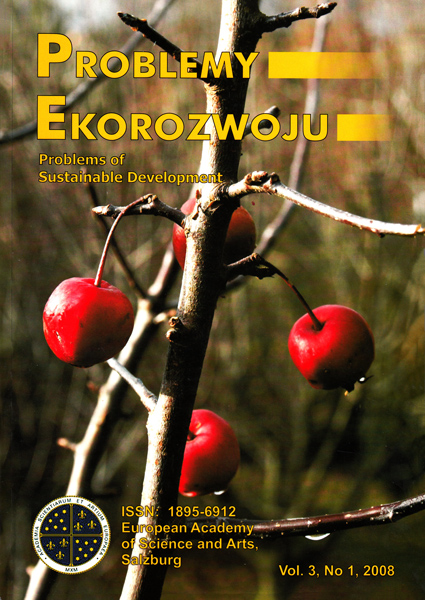Promoting Sustainability Through Green Chemistry, Part 2
Article Sidebar
Open full text
Issue Vol. 3 No. 1 (2008)
-
Stefan Kozłowski (1928-2007): Interwoven to the Rhythm of Nature
Krystyna Bonenberg5
-
The Role of Social Sciences and Philosophy in Shaping of the Sustainable Development Concept
Artur Pawłowski7-11
-
Sustainable Capitalism: A Matter of Ethics and Morality
John Ikerd13-22
-
Emission Reduction of Greenhouse Gases: Emission Quotas or Mandated Control Technologies
Dan Golomb23-25
-
The Philosophical and Social Conditioning of Sustainable Development
Zbigniew Hull27-31
-
Dilemmas for Sustainable Development in Poland
Jacek Jaśkiewicz33-38
-
Promoting Sustainability Through Green Chemistry, Part 1
Tadeusz Paryjczak39-44
-
Promoting Sustainability Through Green Chemistry, Part 2
Tadeusz Paryjczak45-51
-
Sustainable Development in Contemporary Civilisation. Part 1: The Environment and Sustainable Development
Artur Pawłowski, Lucjan Pawłowski53-65
-
The Philosophy of Dialogue as One of the Aspects to Sustainable Development
Irena Grochowska67-72
-
The Human-Animal Relationship in its Ecological Aspect
Stanisław Jedynak73-76
-
Book Review: Democracy in Space. Criticism of the Idea of “New Civilization” Presented by Prof. H. Skolimowski in His Book “Philosophy for a New Civilization”/ Recenzja
Paweł Dybel77-80
Archives
-
Vol. 5 No. 2
2010-07-01 21
-
Vol. 5 No. 1
2010-01-04 16
-
Vol. 4 No. 2
2009-07-01 19
-
Vol. 4 No. 1
2009-01-05 22
-
Vol. 3 No. 2
2008-07-01 19
-
Vol. 3 No. 1
2008-01-02 12
-
Vol. 2 No. 2
2007-07-02 13
-
Vol. 2 No. 1
2007-01-02 11
-
Vol. 1 No. 2
2006-07-03 15
-
Vol. 1 No. 1
2006-01-02 8
Main Article Content
Authors
Abstract
Green Chemistry is an important tool in the achievement of sustainability. Its implementation, along with the design of chemical products and processes that reduce or eliminate the use and generation of hazardous substances, is essential if the expanding global populations are to enjoy an increased standard of living without exerting a negative impact on the health of the planet. One of the major goods of sustainability is the maintenance of an optimal balance between increased manufacturing output and a clean and safe environment. Cleaner technologies will allow chemical enterprises to provide society with the good and services on which it depends, albeit in an environmentally responsible manner. Green chemistry can provide solutions for such global challenges as climate change, sustainable agriculture, energy, toxics in the environment and the depletion of natural resources. A collaborative effort by industry, the academic world and government is needed to promote the adoption of the green chemistry technologies necessary to put a sustainable society in place.
Keywords:
References
ARUNAJATESAN V., SUBRAMANIAM B., HUTCHENSON K.W., HERMES F.E., 2001, Fixed Bed Hydrogenation of Organic Compounds In Supercritical Carbon Dioxide, w: Chemical Engineering Science, No 56, 1363- 1369.
BOYDE S., 2002, Green Lubricants. Environmental Benefits and Impacts of Lubrification, w: Green Chemistry, No 4, 293.
BRANDT C., 2002, Sustainable Development and Responsible Care-Die w: Chemische Industrie auf dem Veg in Eine Grüne Zukunft, No 36(4), 224.
ELBASHIR N.O., DUTTA P., MANIVANNAN A., SEEHRA M.S., ROBERTS C.B., 2005, Impact of Cobalt-Based Catalyst Characteristics on the Performance of Conventional Gas-Phase and Supercritical-Phase Fisher-Tropsch Synthesis, w: Applied Catalysis, No 285, 169- 180.
HORVATH J.T., JOO F., Aqueous Organometallic Chemistry and Catalysis, Kluwer Academic Publishers, Dordrecht 1995.
HOFFER R., BIGORRA J., 2007, Green Chemistry – a Sustainable Solution for Industrial Specialties Applications, w: Green Chemistry No 9, 2003-2012.
HOFFER R., Perspectiven Nachwachsender, Rohstoffe in der Chemie, Winheim, New York, Basel, Cambridge, Tokyo, 1996.
HYDE J.R., LICENCE P., CARTER D., POLIAKOFF M., 2001, Continous Catalytic Reactions, 2001.
JESSOP P., LEITNER W., Chemical Synthesis Using Supercritical Fluids, Wiley-VCH, Weinheim 1999.
JUNG J., PERRUT M., 2001, Particle Design Using Supercritical Fluids, Literature and Patent Survey, w: Journal of Supercritical Fluids, No 20, 179-219.
LI C., 2005, Chemical Reviev, Vol 105, 3095.
LUTHER R., Lubricants in the Environment in Lubricants and Lubrication, w: Ullmann’s Encyclopedia of Industrial Chemistry, Wiley VCH, Weinhem, New York, Chichester, Brisbone, Singapore, Toronto, 2002.
MENDES R.L, REIS A., PEREIRA A., CARDOSO M., PALAVRA A., COELHO J., Supercritical CO2 Extraction of γ Linolenic Acid (GLA) from the Cyanobacterium Arthrospira(Spirulina), Maxima: Experiments and Modeling, w: Chemical Enginering Journal, No 105, 147-152.
PARYJCZAK T., LEWICKI A., 1985, Kataliza w zielonej chemii, w: Przemysł Chemiczny Vol. 85/2, 2-12.
PARYJCZAK T., LEWICKI A., ZABORSKI M., Zielona Chemia, PAN oddział w Łodzi, Komisja Ochrony Środowiska, Łódź, 2005.
PERNAK J., 2003, Ciecze jonowe. Związki na miarę XXI wieku, w: Przemysł Chemiczny, Vol. 8, 521.
PRAJPATI D., GOHAIN M., 2004, Recent Advances In the Application of Supercritical Fluids for Carbon-Carbon Bond Formation in Organic Synthesis, w: Tetrahedron, No 60, 815- 833.
ROMERO M.D., CALVO L., ALBA C., HABULIN M., PRIMOZIC M., KNEZ Z., 2005, Enzimatic Synthesis of Isoamyl Acetate with Immobilized Candida Autaretica Lipase in Supercritical Carbon Dioxide, w: Journal Supercritical Fluids, No 33, 77-84.
SHI B., JACOBS G., SPARKS D., DAVIS B.H., 2005, Fisher-Tropsch Synthesis; 14C Labeled 1-alkene Conversion Using Supercritical Conditions with Co/Al2O3, w: Fuel, No 84, 1093-1098.
STAHL E., QUIRIN K.W., GERARD D., Dense Gases of Extraction and Refining, Springer-Verlag, Berlin, Heidelberg, 1998.
STAHL E., Extraction with Supercritical Gases, Verlag Chemie GmbH, Wenheim, 1980.
TANCHOUX N., LEITNER W., Handbook of Green Chemistry and Technology, Blackwell Oxfrod 2002.
Article Details
Abstract views: 67
License

This work is licensed under a Creative Commons Attribution-ShareAlike 4.0 International License.


